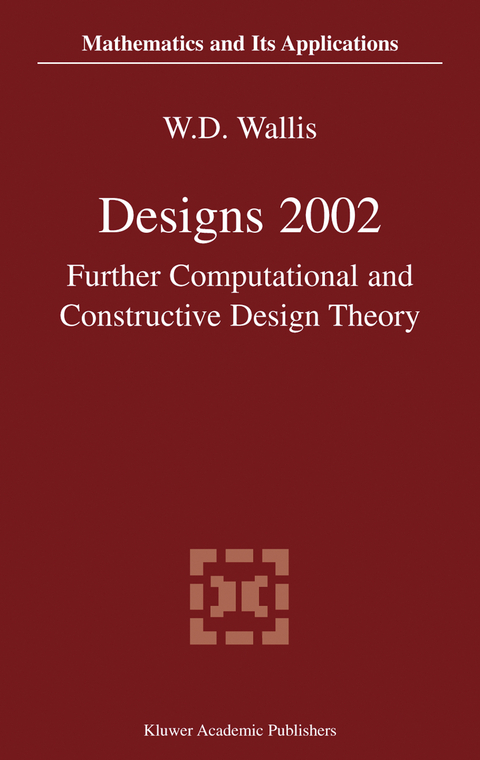
Designs 2002
Springer-Verlag New York Inc.
978-1-4613-7958-4 (ISBN)
1 The Existence of 2-SOLSSOMs.- 1 Introduction.- 2 Direct Constructions.- 3 Recursive Constructions.- 2 Conjugate Orthogonal Diagonal Latin Squares with Missing Subsquares.- 1 Introduction.- 2 Preliminaries.- 3 Direct Construction.- 4 Recursive Construction.- 5 A General Bound.- 6 The Case 2 ? n ? 6.- 3 Combinatorial Trades: a Survey of Recent Results.- 1 Introduction and Preliminaries.- 2 Trades in designs.- 3 Trades in latin squares.- 4 Trade uses.- 5 Latin representations and trades used in tripartite decompositions.- 6 ?-way trades.- 7 Graphical trades.- 8 Future directions.- 4 Two-stage Generalized Simulated Annealing for the Construction of Change-Over Designs.- 1 Introduction.- 2 Notation and Definitions.- 3 A Two Stage Generalized Simulated Annealing Algorithm.- 4 Performance of the Two-Stage GSA.- 5 New Lower Bounds on the Maximum Number of Mutually Orthogonal Steiner Triple Systems.- 1 Introduction.- 2 Starters over Finite Fields.- 3 Automorphisms and Hill-climbing.- 4 Conclusion.- 6 On minimal defining sets in AG(d, 3).- 1 Background.- 2 Introduction.- 3 Further Preliminaries.- 4 Proof of the Main Theorem.- 5 Sets of good hyperplanes in AG(d, 3).- 6 Related critical sets.- 7 Appendix.- 7 Hadamard Matrices, Orthogonal designs and Construction Algorithms.- 1 Algorithms for constructing Hadamard matrices.- 2 On inequivalent Hadamard matrices.- 3 Algorithms for constructing orthogonal designs.- 4 Short amicable sets and Kharaghani type orthogonal designs.- 8 Constructing a Class of Designs with Proportional Balance.- 1 Proportionally balanced designs.- 2 The method of construction.- 3 Feasible parameters for ? = 2, 3 and 4.- 4 Constructions motivated by Construction 5.- 9 Constructions Using Balanced n-ary Designs.- 1 Introduction.- 2 Balanced n-aryDesigns.- 3 Our Construction.- 4 Some Examples.- 5 Some Non-existence Results.- 6 An Improved Construction.- 7 Quadratic Residues.- 8 Another Improvement.- 9 An Application.- 10 More Difference Families.- 10 Sets of Steiner Triple Systems of Order 9 Revisited.- 1 Introduction.- 2 Large sets.- 3 Results.- 4 Uniformly intersecting sets.- 11 Solving Isomorphism Problems for t-Designs.- 1 Introduction.- 2 Basics.- 3 Moebius Inversions.- 4 Extensions of designs.- 12 Finding Double Youden Rectangles.- 1 Introduction.- 2 Definitions and Literature.- 3 Examples.- 4 Searching for a 13-cyclic 13 ? 40 DYR.- 5 Isomorphism.- 6 Further Properties of our new DYRs.- 7 Check for Balance.- 13 Kirkman Triple Systems and their Generalizations: A Survey.- 1 Introduction.- 2 Constructions for Kirkman Triple Systems and Nearly Kirkman Triple Systems for all admissible orders.- 3 Early Generalizations.- 4 Resolvable Packings and Coverings of v points where v ? 0 (mod 3).- 5 Other Generalizations.- 6 Conclusion and Acknowledgements.
| Erscheint lt. Verlag | 11.7.2012 |
|---|---|
| Reihe/Serie | Mathematics and Its Applications ; 563 | Mathematics and Its Applications ; 563 |
| Zusatzinfo | XII, 368 p. |
| Verlagsort | New York, NY |
| Sprache | englisch |
| Maße | 155 x 235 mm |
| Themenwelt | Informatik ► Theorie / Studium ► Algorithmen |
| Mathematik / Informatik ► Mathematik ► Algebra | |
| Mathematik / Informatik ► Mathematik ► Angewandte Mathematik | |
| Mathematik / Informatik ► Mathematik ► Graphentheorie | |
| ISBN-10 | 1-4613-7958-X / 146137958X |
| ISBN-13 | 978-1-4613-7958-4 / 9781461379584 |
| Zustand | Neuware |
| Informationen gemäß Produktsicherheitsverordnung (GPSR) | |
| Haben Sie eine Frage zum Produkt? |
aus dem Bereich


